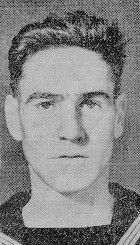Personal Profile Collections

A5720 Leading Stoker Roderick McKenzie
Lost at Sea September 20, 1943
Short Biography:
Roderick McKenzie was born in North Sydney, NS, on February 20, 1917, the son of Roderick and Mary McKenzie. Before the Second World War, he worked as a fireman on the SS Aspy, a coastal steamer that carried passengers, freight, livestock and mail between North Sydney and communities along the northern coast of Cape Breton. He and his wife Annabell lived on Ocean Street in Sydney Mines.
On October 21, 1942, Roderick enlisted with the Royal Canadian Naval Reserve (RCNR), a reserve force that provided support for the Royal Canadian Navy and consisted of pre-war professional sailors. Roderick’s rank was leading stoker. His experience working on the SS Aspy would have led him to join the RCNR. This reserve force, along with their colleagues in the Royal Canadian Naval Volunteer Reserve (RCNVR), who consisted of men with limited or no nautical experience, formed the backbone of the Royal Canadian Navy by the end of the war.
Roderick did his basic and additional training at HMCS Stadacona and HMCS Cornwallis, naval bases located in Halifax. On January 19, 1943, he joined the crew of HMCS Dundas, a Flower class corvette that was based out of Halifax and assigned convoy escort duties operating from the Canadian east coast to the mid Atlantic. On May 13, 1943, after only four months, and shortly before the HMCS Dundas was scheduled for a major refit in Montreal, Roderick was posted back to shore at HMCS Stadacona. The shore posting would not last long. On June 27, 1943, Roderick was assigned to the crew of HMCS St. Croix, an American built “four stacker” destroyer.
HMCS St. Croix was built for the First World War and was launched in 1919 as the USS McCook. It was one of fifty destroyers acquired by the British in 1940 as a part of the British-US destroyers for bases deal. Six of these ships, including the McCook were then transferred to the Royal Canadian Navy. The McCook was renamed HMCS St. Croix, named after the St. Croix River located between New Brunswick and the State of Maine.
Roderick joined HMCS St. Croix after she had already had a short but distinguished career in the Royal Canadian Navy. In late 1940, while sailing for the U.K., she was badly damaged during a hurricane and limped back to Halifax for repairs. In March, 1941, she was assigned convoy escort duties tasked with protecting the ships of the convoys by searching for and attacking German submarines known as u-boats. She did her job well. On July 24, 1942, she sank U-90 in the North Atlantic, and on March 4, 1943, off Portugal, in conjunction with the Canadian corvette HMCS Shediac, she sank U-87.
In September, 1943, HMCS St. Croix, with Roderick on board, was heading for the Bay of Biscay, near France, when she received orders to head north to assist two convoys west of Ireland that were being attacked by a wolf pack, a group of u-boats working together. She responded, and on the night of September 20, 1943, was attacked by U-305 which was using a new weapon, GNAT acoustic homing torpedoes which homed in on the sounds made by propellers. Two of the new style torpedoes struck HMCS St. Croix, severely damaging her, but she managed to stay afloat. She was then struck by a third torpedo causing her to sink within three minutes. Although some of the crew were lost in the sinking, many went into the water and managed to survive in lifeboats and rafts. Because of the on-going battle with wolf pack, help by other escort ships was delayed. Many men that survived the sinking perished awaiting rescue. It was almost thirteen hours before the remaining survivors were picked up by a British destroyer, HMS Itchen. Out of 147 men on the HMCS St. Croix, five officers and 76 ratings were pulled from the water by HMS Itchen, but their troubles were not over. HMS Itchen continued to battle with the German u-boats until the early morning hours of September 23, 1943, when she was struck under her magazine by a torpedo from U-666. There was a tremendous explosion and the ship sank in 40 seconds. In the end there were only two survivors from HMS Itchen and one survivor, Stoker William Fisher, from HMCS St. Croix.
It is not known whether Roderick McKenzie died during the actual sinking of HMCS St. Croix, awaiting rescue at sea, or during the sinking of HMS Itchen. His official date of death is September 20, 1943. He was 26 years old. Roderick is commemorated on the Halifax Memorial located in Point Pleasant Park, Halifax, NS. The memorial lists the names of 3100 members of the Canadian Forces who were lost at sea and have no known graves.